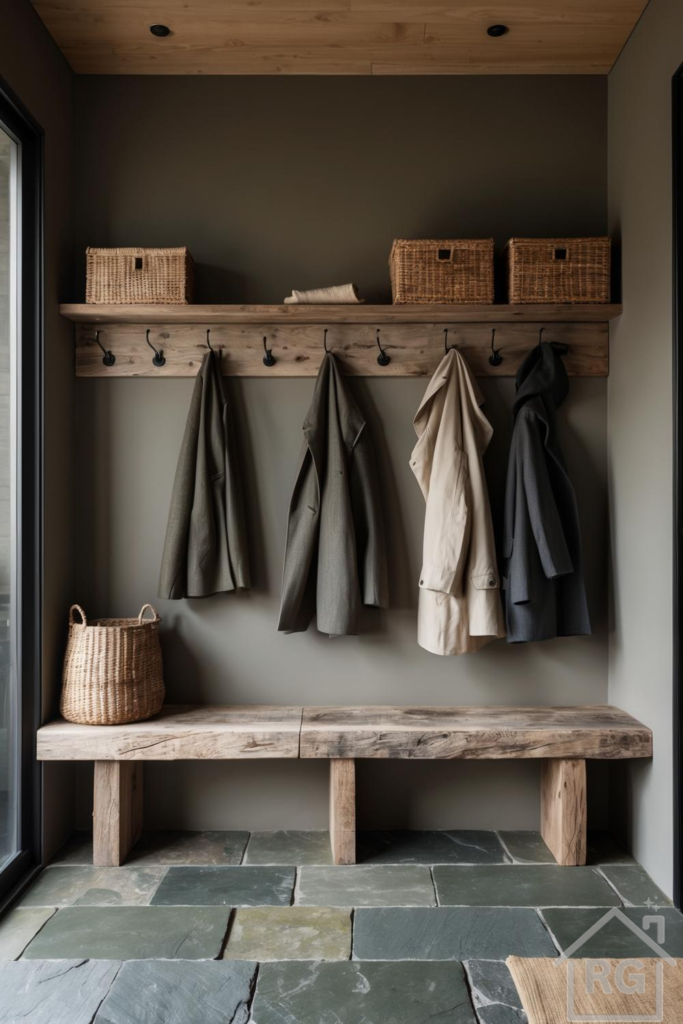
Embracing Nature’s Palette: Crafting a Rustic Mudroom Sanctuary
The entryway or mudroom is often the first and last space we experience in our homes each day. It’s a transitional zone, a place to shed the outside world and prepare to embrace the comfort within, or vice versa. Creating a mudroom that is not only functional but also beautiful and calming can significantly enhance our daily routines. This guide explores how to achieve a stunningly rustic and earthy mudroom, drawing inspiration from natural materials, a grounding color palette, and thoughtful design principles.
The Foundation: An Earthy Color Palette
The color scheme in this rustic mudroom is paramount to its serene and welcoming atmosphere. The walls, painted in a deep, muted olive green, evoke a sense of being enveloped by nature. This isn’t a bright, energetic green, but rather a complex, earthy tone that feels grounding and sophisticated. It absorbs light beautifully, creating a cozy, cocoon-like effect, perfect for a space designed for transition and respite.
Complementing the rich green are various shades of natural wood. From the lighter, warm tones of the ceiling planks to the medium, weathered browns of the wall-mounted shelf and the robust bench, wood introduces warmth and organic texture. These wooden elements aren’t uniform; their grains, knots, and slight imperfections tell a story of authenticity. The palette is further deepened by the charcoal grey of the coats and the varied grey-greens of the slate floor, creating a harmonious blend of nature-inspired hues. Accents of creamy beige, seen in one of the coats and the woven baskets, provide subtle highlights and prevent the space from feeling too dark.
Celebrating Textural Richness: Materials that Speak Volumes
Texture plays a crucial role in bringing a rustic design to life, adding depth and tactile interest. This mudroom is a masterclass in layering natural materials:
- Reclaimed Wood: The star of the show is undoubtedly the reclaimed wood used for the bench and shelf. This timber, with its visible history – perhaps slight weathering, old nail holes, or a beautifully aged patina – brings unparalleled character. It’s not just a surface; it’s a piece with a past. The raw, unfinished quality of the bench, in particular, emphasizes its rustic charm. Running your hand over it, you’d feel the slight undulations and the sturdy, honest grain.
- Slate Stone Flooring: Underfoot, large rectangular slate tiles provide a durable and visually appealing foundation. Slate is a natural stone known for its rich, varied coloration, often displaying shades of grey, green, blue, and even hints of rust. Its naturally uneven surface offers slip resistance – a practical benefit for a mudroom – and its cool touch contrasts beautifully with the warmth of the wood. Each tile is unique, contributing to the overall organic feel of the space.
- Woven Rattan Baskets: Storage is key in a mudroom, and the use of woven rattan baskets is both practical and aesthetically pleasing. Placed on the shelf and on the floor, these baskets introduce another layer of natural texture. The intricate weave of the rattan adds a softer, more pliable element compared to the hard wood and stone, and their light, natural color provides a gentle visual break. They whisper of handcrafted quality and simple, functional beauty.
- Wrought Iron Hooks: Simple, sturdy wrought iron hooks are mounted along the wooden shelf. Their dark, matte finish provides a strong visual contrast against the lighter wood and the olive wall. These hooks are utilitarian yet possess an understated elegance, reminiscent of traditional blacksmithing. They feel robust and reliable, ready to hold the weight of daily life.
- Natural Fiber Fabrics: The coats hanging from the hooks, likely made of linen, wool, or heavy cotton, contribute their own subtle textures. These natural fibers align perfectly with the overall organic theme, adding a touch of softness and everyday reality to the curated design.
Key Furniture and Functional Elements
A successful mudroom balances aesthetics with robust functionality. Every piece in this design serves a purpose while contributing to the overall style:
- The Sturdy Wooden Bench: More than just a place to sit while removing shoes, the bench is a grounding element. Its thick, solid wood construction speaks of durability and timelessness. Its simple, almost primitive design enhances the rustic appeal. Imagine the convenience of this perch after a long day, a moment to pause before fully entering the home.
- Wall-Mounted Shelf and Coat Rack: Maximizing vertical space is essential in often-compact mudroom areas. The wooden plank shelf provides a platform for the storage baskets, keeping smaller items organized and out of sight. Below it, the row of hooks offers ample space for coats, bags, and scarves, ensuring the area remains tidy. This integrated unit is a practical workhorse, seamlessly blending into the design.
- Strategic Lighting: Though the image shows a subtly lit space, likely benefiting from natural light from an adjacent window (implied by the window frame on the left), the presence of a small, recessed downlight in the wooden ceiling indicates thoughtful illumination. In a mudroom, good lighting is crucial for finding items and creating a welcoming ambiance. A layered approach, perhaps combining overhead lighting with task lighting near a mirror (if space allows), is often ideal.
Achieving This Look in Your Home: Tips and Considerations
Recreating this rustic and earthy mudroom aesthetic is achievable with careful planning and material selection:
- Start with the Walls: Choose a deep, muted earth tone for your walls. Consider shades like olive green, warm grey, terracotta, or a desaturated deep blue. Test samples in your space to see how they interact with your natural light.
- Source Your Wood Wisely: Look for reclaimed timber for shelves and benches. Architectural salvage yards, local woodworkers, or even online marketplaces can be great resources. If reclaimed isn’t feasible, opt for new wood with a visible grain and consider distressing techniques or natural oil finishes to achieve an aged look.
- Select Natural Flooring: Slate is an excellent choice, but other natural stones like travertine or even textured porcelain tiles that mimic stone can work well. Consider durability and ease of cleaning.
- Incorporate Woven Elements: Baskets are a must! Look for rattan, seagrass, or water hyacinth baskets in various sizes. They add texture and are incredibly versatile for storage.
- Choose Hardware with Character: Opt for matte black, oil-rubbed bronze, or antique brass hooks and hardware. Simple, sturdy designs often work best in a rustic setting.
- Don’t Forget Functionality: Plan your storage needs carefully. How many hooks do you need? What size bench is appropriate for your space? Is there room for shoe storage beneath the bench or in cubbies?
- Keep it Uncluttered: While rustic design embraces character, it doesn’t mean clutter. The beauty of this space lies in its organized simplicity. Ensure everything has a place.
- Add Personal Touches (Subtly): While this example is quite minimalist, you could add a small, framed nature print, a vintage mirror, or a hardy indoor plant if space and light permit, to further personalize the area without detracting from the core aesthetic.
The Sensory Experience: More Than Just Visuals
This mudroom design appeals to more than just the eyes. Imagine the cool, solid feel of the slate underfoot, the slightly rough texture of the reclaimed wood bench, the smooth, sturdy iron of the hooks. The scent of natural wood and perhaps even the faint, earthy aroma of damp coats on a rainy day contribute to the overall sensory experience. It’s a space that feels honest, grounded, and deeply connected to the natural world.
Conclusion: A Welcome Retreat
Creating a rustic and earthy mudroom is about crafting a space that is both a practical workhorse and a calming retreat. By focusing on a nature-inspired color palette, embracing the beauty of natural materials with their inherent textures and imperfections, and prioritizing functional simplicity, you can design an entryway that welcomes you home with warmth and tranquility. It’s an invitation to slow down, shed the stresses of the outside world, and step into a space that feels both timeless and deeply personal.
